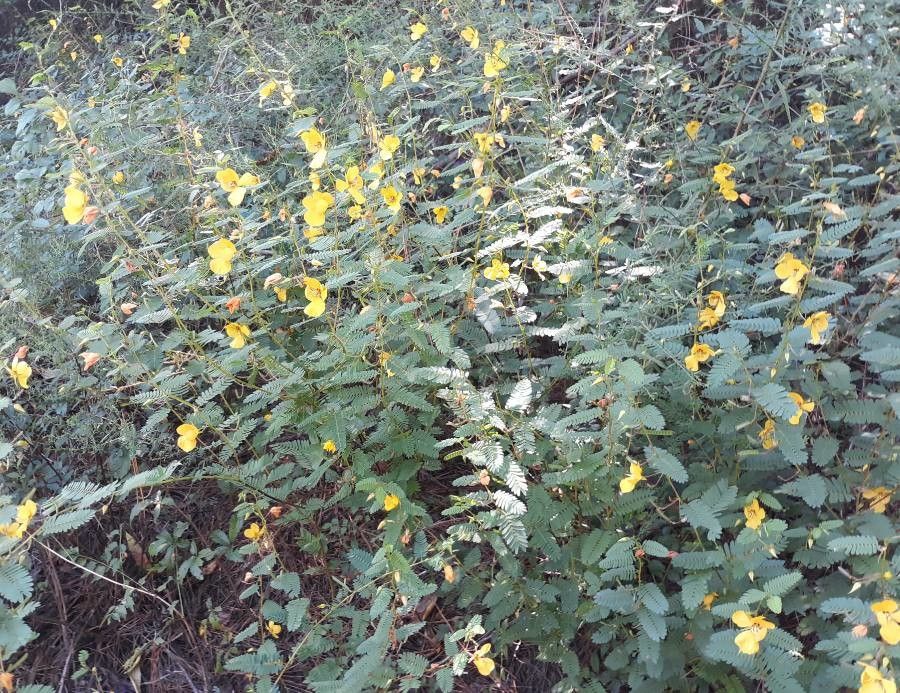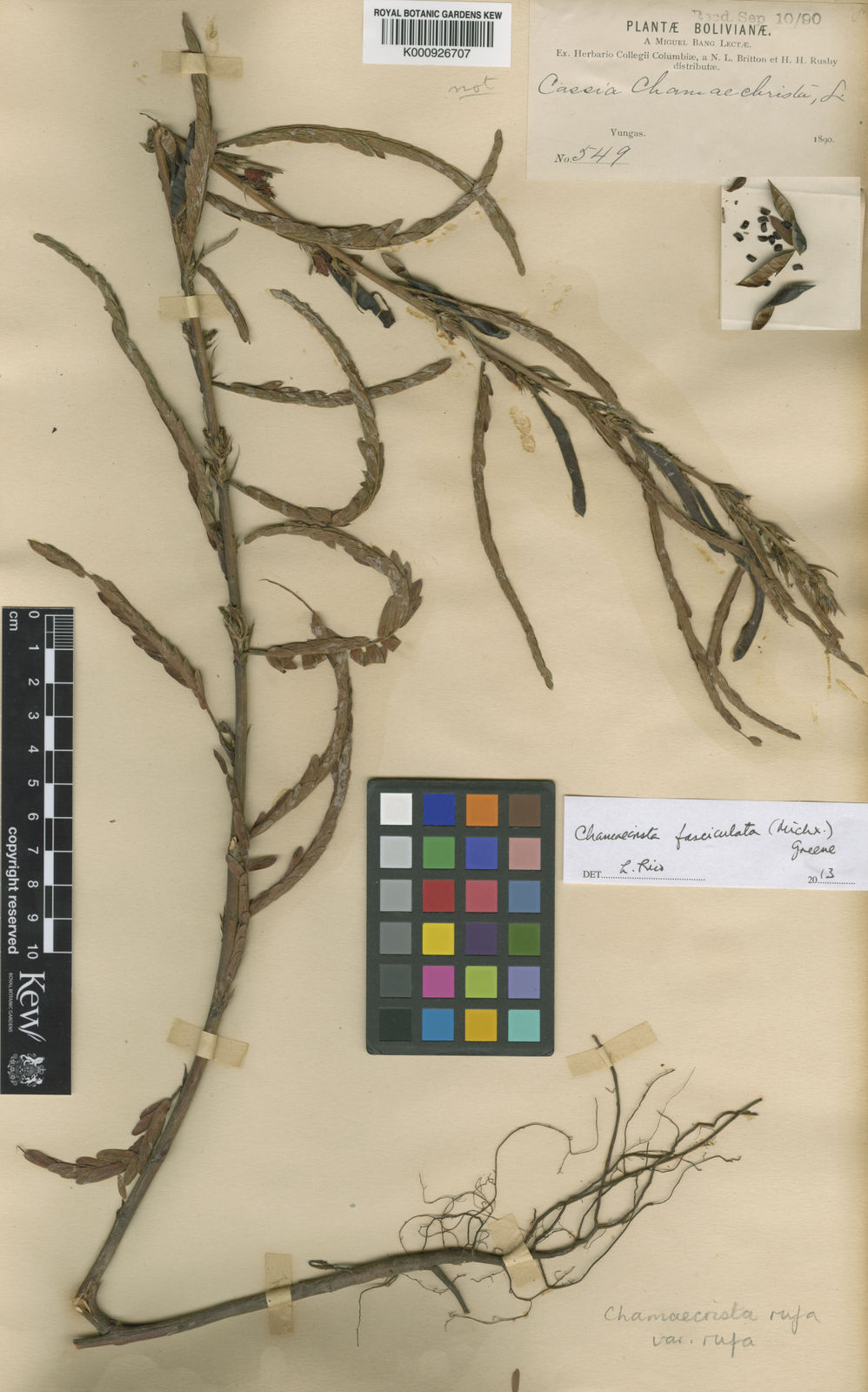Partridge Pea
chamaecrista fasciculata
Also known as: ["Partridge Pea","Fuzzy Senna","Bee Bean"]
Overview
A native annual herbaceous plant with showy yellow flowers and pinnate leaves, often found in open fields and meadows.
Benefits & Perks
["long-flowering","wildlife attractant (bees, butterflies, birds)","drought tolerant","low maintenance"]
Botanical Classification
| Phylum: | Magnoliophyta |
| Class: | Magnoliopsida |
| Order: | Fabales |
| Family: | Fabaceae |
| Genus: | Chamaecrista |
| Botanical Name: | Chamaecrista fasciculata |
Plant Characteristics
Basic Information
- Category: Flowers
- Suitable Location: open garden beds or containers in full sun
- Suitable For:
- Is Weed: No
- Allergenicity: low
Environmental Needs
- Climate: {"temperatureRange":"10–35°C"}
- Hardiness: {"zones":"7–10"}
- Misting: rarely required, only if ambient humidity is very low
- Drainage: Fast-draining to prevent waterlogging.
- Soil Type: Well-draining, loamy soil with added organic matter; can tolerate sandy soils.
Maintenance Level
- Maintenance Level: low
- Toughness Level: high
- Pruning Frequency: Light pruning can be done anytime; major pruning in late winter or early spring before new growth begins.
- Pruning Intensity: Light to moderate; avoid heavy pruning unless necessary to control size or shape.
Care Details
Ideal Sunlight Coverage:
Full sun (6–8 hours of direct sunlight daily); tolerates partial shade but may flower less.
Sunlight Tolerance Tips:
Acclimate plants gradually to intense sunlight; protect from harsh afternoon sun in hot climates; ensure proper ventilation if grown indoors.
Care Requirements
Care Difficulty
easymoderate
Sunlight
full sun to partial shade
Rotate plant for even light exposure; use sheer curtains to filter intense sun; avoid placing near heat sources.
Watering
every 7–10 days during active growth, less frequently in dormancy
Water thoroughly but infrequently; ensure good drainage; avoid wetting foliage.
Soil
well-draining, sandy loam with moderate organic content
pH: Slightly acidic to neutral (pH 6.0–7.0).
Use a mix of potting soil and perlite; avoid heavy clay soils; ensure pots have drainage holes.
Temperature
Prefers warm conditions (65–85°F or 18–29°C); thrives in full sun but can tolerate brief periods of cooler temperatures.
Monitor temperature fluctuations; adjust watering based on heat; protect from drafts or sudden temperature drops.
Fertilizing
every 4–6 weeks during growing season, none in winter
Apply fertilizer to moist soil to prevent root burn; flush soil occasionally to prevent salt buildup; reduce feeding for mature plants.
Propagation
Methods
Stem cuttings or seed; stem cuttings are faster and more reliable for home growers.
Step-by-Step Propagation Guide
- Take a 4–6 inch cutting with at least two nodes.
- Remove lower leaves.
- Dip in rooting hormone (optional).
- Plant in moist medium.
- Keep humid and warm.
Best Time: Spring or early summer when the plant is actively growing.
Environment
Warm (70–75°F or 21–24°C), humid, and bright but indirect light; protect from direct sun.
Medium
Well-draining potting mix (e.g., perlite and peat moss) or water for initial rooting.
Hormone
Rooting hormone is optional but recommended for faster rooting.
Timeline
Roots may develop in 2–4 weeks; new growth appears in 6–8 weeks.
Tools Needed
Pruning shears, rooting hormone, small pots, well-draining medium, plastic wrap or propagator.
Quick Tips
Use sharp, clean tools to prevent disease; maintain high humidity for faster rooting; avoid overwatering cuttings.
Pruning & Repotting
Pruning Guide
Method
Pinch back tips to encourage branching; cut stems just above a leaf node or bud.
Pruning Plan
Prune to maintain shape, encourage bushier growth, and remove dead or weak stems.
Tools
Pruning shears, sharp scissors, or your fingers for small stems.
Checklist
Use clean tools; prune dead or damaged growth; shape the plant as desired; avoid removing more than one-third of the plant at once.
Repotting Guide
Best Season
Early spring before the growing season begins.
Pot Size
Choose a pot one size larger (1–2 inches wider in diameter) than the current one.
Method
Remove the plant gently; trim any circling roots; place in a new pot with fresh, well-draining soil; water thoroughly after repotting.
Suggestions
Repot every 2–3 years or when the plant becomes root-bound; beneficial for maintaining vigor and growth.
Checklist
Select appropriate pot size; prepare fresh soil mix; handle roots carefully; water after repotting; place in appropriate light.
Advanced Care Tips
Watering Mastery
Watering Checklist
Check soil moisture before watering; water deeply; ensure drainage; avoid overhead watering.
How to Apply Water Properly
Water at the base of the plant, ensuring moisture reaches the root zone; allow excess water to drain away; water in the morning to reduce evaporation.
Watering Schedule Tips
Water deeply once the top inch of soil is dry; reduce frequency in winter to prevent root rot.
Soil Improvement
Add perlite or coarse sand for drainage; incorporate compost for fertility; ensure soil is loose and airy.
Temperature Stress Management
Signs of Temperature Issues
Wilting, yellowing leaves, or stunted growth in cold; scorching or leaf drop in excessive heat.
Cold Stress
Growth slows or halts; leaves may turn yellow or brown; risk of frost damage in freezing temperatures.
Solution: Move to a warmer location; provide frost protection in cold climates; avoid overwatering during cold periods.
Hot Stress
Leaves may scorch, wilt, or drop; flowering may be reduced; soil may dry out too quickly.
Solution: Provide partial shade during peak heat; increase watering frequency; use mulch to retain soil moisture.
Fertilizing Guide
Fertilizing Checklist
Use diluted fertilizer; apply during active growth; avoid winter feeding; flush soil periodically.
Fertilizing Method
Use a balanced, water-soluble fertilizer diluted to half strength; fertilize every 4–6 weeks during the growing season (spring and summer); avoid fertilizing in fall and winter.
Common Problems & Solutions
Toxicity Warning
Cats
Non-toxicChamaecrista fasciculata is not known to be toxic to cats. It does not produce any known harmful compounds that would cause adverse effects in felines.
⚡ Toxic If:
if eaten
Dogs
Non-toxicChamaecrista fasciculata is not known to be toxic to dogs. It does not produce any known harmful compounds that would cause adverse effects in canines.
⚡ Toxic If:
if eaten
Humans
Non-toxicChamaecrista fasciculata is not known to exhibit toxic effects in humans. It is generally considered safe for consumption.
⚡ Toxic If:
if eaten
Frequently Asked Questions
Q: Does Chamaecrista fasciculata attract pollinators?
A: Yes, it is highly attractive to bees, butterflies, and other pollinators.
Q: Is this plant suitable for dry conditions?
A: Yes, it is drought-tolerant and thrives in well-drained soils.
Q: Can Chamaecrista fasciculata be grown in containers?
A: While possible, it is best suited for open ground due to its spreading habit.
Quick Reference
| Family: | Fabaceae |
| Care: | easy |
| Light: | full sun to partial shade |
| Water: | every 7–10 days during activ |
Get Expert Care Tips
Download the Plantious app for personalized care reminders and plant identification!
Google Play App Store






